
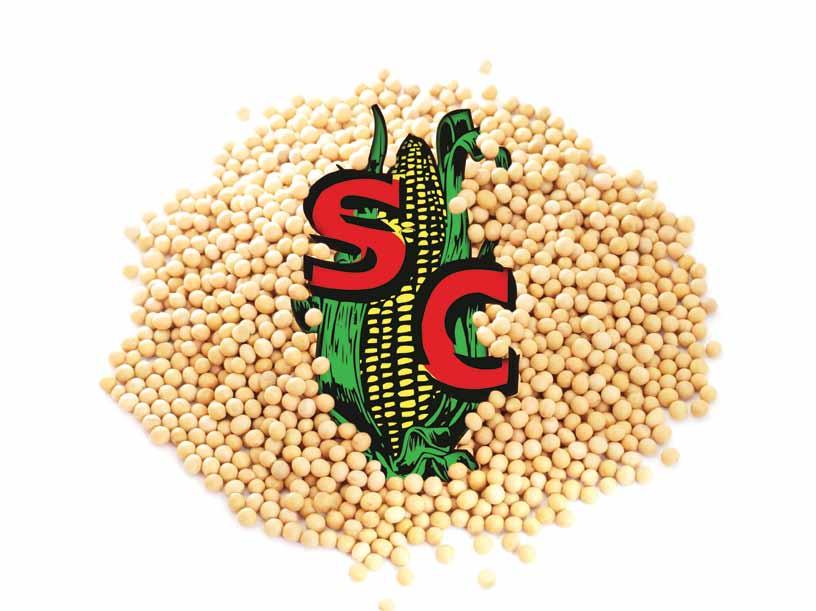
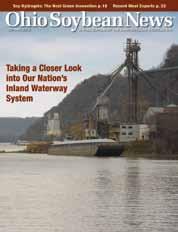
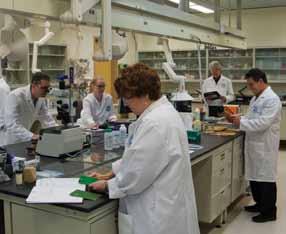


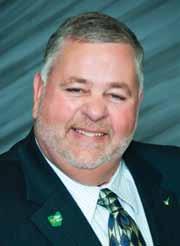
Bret Davis
Ohio Soybean Association Chairman
Delaware County soybean farmer








Bret Davis
Ohio Soybean Association Chairman
Delaware County soybean farmer
Ialways anticipate the months leading up to planting season because we can plan as much as possible, but Mother Nature always plays quite a role in the outcome. While it’s still too early to see what exactly this year’s crop will yield, let’s all continue implementing the best management practices for the 2013 growing season. As we begin planting season let us not forget our largest customer of soybeans: animal agriculture.
U.S. pork and beef exports set a new record in 2012 which has a direct tie to soybeans. It’s no surprise that exports are extremely important to agriculture in Ohio and around the U.S. See pages 22 and 23 to read details on those export records and view the impact soybeans have on an international level. The Ohio Soybean Association (OSA) continues to be proactive by expanding export market opportunities and addressing challenges.
As you read this, OSA farmer leaders will have traveled to Capitol Hill advocating at the state and national level on relevant topics from the past year. OSA will be meeting with many of our legislators to discuss a variety of topics affecting farmers. Topics included are a comprehensive, five-year Farm Bill, biodiesel, trade expansion, biotechnology, regulation, federal budget, transportation infrastructure, aquaculture and sustainability. OSA plans to move the needle and get our legislators to think and act on these priority areas so farmers across Ohio can continue to be successful. We will keep you updated on the outcome of our trip.
Lastly, I would also like to encourage all young farmers to apply for the Beck’s Young Farm Leader Program. OSA has partnered with Beck’s Hybrids to launch a program highlighting young leaders in the agriculture industry. See page 12 for more details on the newly launched program and send in an application today.
President
Jerry Bambauer, Auglaize County
Chairman
Bret Davis, Delaware County
Vice President
Tom Price, Putnam County
Treasurer
Jeff Roehm, Highland County
Secretary
Mike Heffelfinger, Van Wert County
Trustees
Allen Armstrong, Clark County
John Buck, Marion County
Amy Sigg Davis, Warren County
Dave Dotterer, Wayne County
Adam Graham, Logan County
James Heimerl, Licking County
Todd Hesterman, Henry County
Rob Joslin, Shelby County
Ed Lamalie, Sandusky County
Chad McIlvaine, Ross County
Scott Metzger, Ross County
Lane Osswald, Preble County
Bruce Simmons, Medina County
Bob Slicker, Stark County
Jeff Sollars, Fayette County
Industry Affiliates
Kathy Alvarez, Bunge N.A.
Bill Tom, Cargill, Inc.
American Soybean Association Board
Representatives
Bret Davis
Rob Joslin
Jeff Sollars
Staff Credits
Adam Ward – Publisher
Jennifer Coleman – Editor
Katie Bauer – Staff Writer
Judy Brent – Production Manager
Dale Hahn – Designer
Ohio Soybean News is published six times a year by the Ohio Soybean Association, 918 Proprietors Rd., Suite A, Worthington, OH 43085 Phone: 614-476-3100. For address corrections contact Ohio Soybean News at 918 Proprietors Road, Suite A, Worthington, Ohio 43085. Web address: www.soyohio.org E-mail: cdeboard@soyohio.org

Comments and statewide news articles should be sent to the above address. Advertising space reservations must be made by the first of the month preceding publication. In consideration of the acceptance of advertisement, the agency and the advertiser must, in respect of the contents of the advertisement, indemnify and save the publisher harmless against any expense arising from claims or actions against the publisher because of the publication of the content of
For Advertising Information Call: Tom Shearing
Advertising Sales Manager Phone: 585-476-2426


We’re helping you write a better end to this story.
We’re investing your soybean checkoff dollars to build awareness among businesses and organizations about deteriorating transportation infrastructure like Ohio’s lock and dam system. These systems are vital to your ability to transport your soybean crop and affect profitability and international demand. This
checkoff.


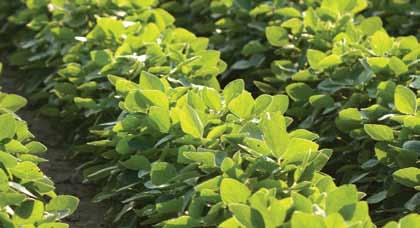
When it comes to choosing which seed to plant, soybean selection is driven by the need for certain characteristics and traits more than nearly any other crop. The options available are great for soybean farmers, but they also force soybean breeders to stay on their toes and to be aware of emerging issues.
Robert Waller, product development agronomist for Dow AgroSciences, is charged with recognizing the agronomic challenges farmers face and then delivering seed necessary to meet them. Waller says Dow AgroSciences strives to identify the key attributes a seed needs to succeed in a particular environment. Some areas of the country need iron deficiency chlorosis, sudden death syndrome or phytophthora tolerance in order to reach their full yield potential. Farmers in those regions are at a disadvantage if varieties in the desired maturity featuring the resistance characteristics they need aren’t available. That’s why it’s vital for breeders to stay one step ahead of diseases and provide the seed farmers need when it’s needed.
Waller says “when we see disease issues, we start asking ‘what do we need to do to address these problems?’”
Wherever soybeans are grown, Waller stresses that it’s usually just a matter of time before disease problems begin to emerge. He says farmers in northern Minnesota used to think soybean cyst nematode wouldn’t be an issue for them, but now it is showing up with increased frequency. Frogeye leaf spot is a foliar soybean disease typically found in hot, humid climates that it is becoming more evident in soybean fields as far north as Iowa.
In addition to doing their own work, Waller says Dow AgroSciences researchers also collaborate with university scientists on the forefront of soybean breeding and testing. The additional resources are valuable because when it comes to discovering the presence of yield-robbing soybean diseases, it’s typically when, not if.
“Our field research and laboratories give us a lot of tools at our disposal,” he adds. “While we are focused on bringing the best new products to market, we can’t lose sight of what’s important. For a complete package, you have to start with a good backbone of genetics and disease resistance.
“There are always emerging problems we are trying to address. Before farmers begin to talk about a disease, we need to start breeding for it so we have seed with the characteristics and traits available when they become must-haves.”
Brought to you by:
he Ohio Soybean Association (OSA) welcomed provisions in legislation passed by the House and Senate to avoid the year-end fiscal cliff. Included in the fiscal cliff package was an extension of the biodiesel tax incentive and a permanent solution to the estate tax.
The two provisions included in the fiscal cliff package are two resounding victories for soybean farmers and have been priorities of OSA and the American Soybean Association (ASA) in recent years.
With the biodiesel tax incentive, the extension of the dollarper-gallon credit retroactive to 2012 and through 2013 is quite a success for the growing biodiesel industry which remains a crucial market for soybean farmers.
The two provisions included in the fiscal cliff package are two resounding victories for soybean farmers.

On the estate tax side, OSA welcomed Congressional action so the estate tax did not revert back to levels unrealistic for family farms.
The estate tax was permanently set at a rate of 40 percent on estates valued at $5 million, or $10 million per couple, a much more practical solution for the land-based and capital-intensive nature of family operated farms today.
OSA, alongside ASA recognizes and appreciates the recent policy provisions which will benefit growers around the United States.
“OSA commends the House and Senate for taking the necessary steps to solve tax issues, specifically the biodiesel tax incentive and estate tax which have a major effect on soybean farmers,” said Bret Davis, OSA chairman and soybean farmer from Delaware County. u
The Ohio Soybean Association (OSA) works to provide leadership for Ohio’s soybean farmers by promoting effective policies and legislation in support of a growing and profitable soybean industry. Because OSA is a member-supported organization with over 2,000 members, your support through membership is a vital part of continuing to unite soybean producers, legislators and other influential parties in the agriculture industry.
Being a member of OSA gives you a stronger voice on policy issues in both Washington, D.C. and in Columbus. Your OSA membership gives the association the opportunity to lobby effectively at the state and national levels to advance the interests of Ohio soybean farmers. OSA also works cooperatively with its national affiliate, the American Soybean Association (ASA). When you join OSA you are automatically a member of ASA.
ASA’s primary focus is policy development and implementation. Policy development starts with the farmer/members and culminates at an annual meeting of voting delegates. ASA is tasked with accomplishing the policy goals established by the farmers, members and delegates. ASA does this by testifying before Congress, lobbying Congress and the Administration, contacting members, and meeting with the media. This legislative process cannot happen without member input and support.
Additionally with an OSA membership, you will receive a variety of discounts and other benefits, including the Seed Incentive Program. If your membership is up for renewal this year, please take a moment to renew and ensure your voice is heard in the legislative process. For more information, and to fill out a membership application online, visit www.soyohio. org/membership
Soybean checkoff dollars, managed by the Ohio Soybean Council (OSC), cannot be used for lobbying and legislative activities. That is why your membership is vital to making the soybean industry in Ohio successful and profitable for many years to come.
Join or renew as a 3-year member and receive a coupon worth $195 off the purchase of a minimum of 100 bags of soybean seed from a participating company listed above. u





Ohio Soybean Association 2013 Member Benefits
• 10% discount on one time purchase at Tractor Supply Company†
• Rebate coupon for $.05/gallon up to 2,000 gallons of soy biodiesel†
• Subscription to Ohio’s Country Journal*†
• 6 issues of the Ohio Soybean News magazine*†
• 9 issues of the Ohio Leader Letter - OSA’s member-only newsletter*†
• NEW MEMBERS: Discounted subscription of $20 to Fastline Publications*†
• 10% merchandise discount & 20% discount on safety items at any participating JD Equipment locations†
† 3-year membership incentive
*1-year membership incentive
American Soybean Association Member Benefits: When you join OSA, you will also become a member of the American Soybean Association and enjoy these additional benefits.
• Affinity Center International, “Achieve Links” Program – earn reward points redeemable at more than 1,200 vendors, www.soygrowers.com
• National Biodiesel Board - Ford Partner Recognition X-Plan Vehicle Pricing Program – exclusive savings on eligible Ford and Lincoln vehicles
• National Biodiesel Board - Chrysler Affiliate Reward Program – preferred price of 1% below factory invoice on the purchase or lease of most new Chrysler, Dodge or Jeep vehicles
• SOY Scholarship – children and grandchildren of ASA members are eligible to compete for the $5,000 Secure Optimal Yield Scholarship, www.soygrowers.com/soy/scholarship.htm
• Cabela’s gift cards – 10% discount through a special link on www.soygrowers.com
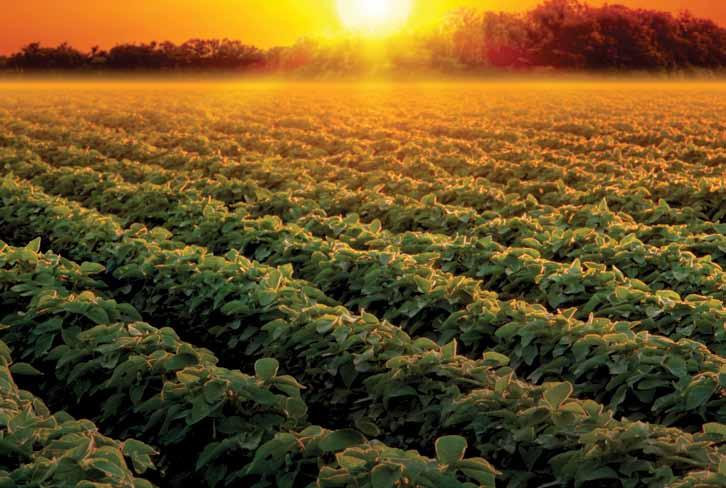




When faced with a variety of disease, insect and harvest challenges, protection from yield loss is key to achieving maximum yield potential. at’s why DuPont Pioneer researchers utilize our exclusive Accelerated Yield Technology (AYT™) system to not only identify genes associated with high yields, but also incorporate defensive and agronomic traits to safeguard that potential. Top it o with Pioneer Premium Seed Treatment to deliver additional protection options, and you can see how we deliver total soybean performance. pioneer.com/soybeans


The National Biodiesel Board (NBB) recently held its annual conference in Las Vegas where farmer- leaders from all around the country saw firsthand how the demand for soybean oil continues to grow.
U.S. Secretary of Agriculture Tom Vilsack wanted to take the opportunity to set the record straight on biofuels during the NBB conference.
“It’s Food AND fuel,” said Vilsack. “We CAN [produce both], we’ve BEEN doing it, and we’ll CONTINUE to do it, because we’re the most efficient farm system in the world.”
The biodiesel industry has done just that in its 20-year history. Originally started by the soybean checkoff, the biodiesel industry has grown into a 1 billion gallon-plus a year business. And, industry experts feel that the young industry is just building momentum.
“Twenty years ago, biodiesel production was nonexistent. Today, production stands at more than one billion gallons annually. Biodiesel demand continues to grow and soybean oil is there to meet that demand,” said Amy Sigg Davis, OSA board member and soybean farmer from Warren County who attended the conference.
U.S. soybean farmers originally looked at biodiesel as a way to use excess soybean oil that weighed down the market. Today, biodiesel accounts for 26 percent of the soybean oil used annually in the United States.
“The development of the biodiesel industry included soybean farmers from the start. The soybean checkoff helped fund a lot of the research that made biodiesel what it is today and helped create the National Biodiesel Board. Soybean farmers today serve in leadership roles throughout the country and continue to play an important role in the biodiesel industry,”
said Jerry Bambauer, OSA president and soybean farmer from Auglaize County who also attended the conference.
Biodiesel remains the only commercially available Advanced Biofuel, according to the EPA’s guidelines for the Renewable Fuel Standard (RFS2). Much of the research proving biodiesel’s sustainability and environmental benefits was also funded by the soybean checkoff at both the state and national level.
Biodiesel production has a positive impact on feed prices as well.
“According to a National Biodiesel Board study, the increased demand for soybean oil has led to lower soybean meal prices of $16 to $48 per ton,” said Bambauer.
challenged equipment manufacturers for support.
Today, the cities of Las Vegas and North Las Vegas, along with school districts and water districts, all run their diesel vehicles on biodiesel.
Attendees saw firsthand how Las Vegas is supportive of the biodiesel industry.
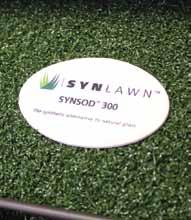
Soy-based backing can be found on more than six acres of artificial grass found at the Wynn, up and down the streets of Vegas and even underneath the carpet in your favorite casinos.
Overall, creating more demand for soybean oil lowers meal prices. Because of biodiesel, soybean oil and meal economics benefit the livestock industry. When demand for soybean oil increases, the price of soybean meal decreases from what it otherwise would cost. For every soybean that’s crushed, the vast majority of it becomes protein meal that is then fed to livestock.
While in Las Vegas, farmer-leaders learned that not everything that happens in Vegas, stays there. Take biodiesel for example. Las Vegas committed to using biodiesel in the 90’s and helped set the stage for other large metropolitan areas to follow suit. Las Vegas helped pioneer biodiesel acceptance and helped overcome resistance, technical obstacles and
“Biodiesel isn’t the only way that Las Vegas is going green with soybeans, it’s also found in artificial lawns and hotel carpets. The soybean checkoff partnered with Universal Textiles Technologies to develop a carpet backing made out of soybean oil,” said Bambauer.
Today, that soybased backing can be found on more than six acres of artificial grass found at the Wynn, up and down the streets of Vegas and even underneath the carpet in your favorite casinos.
“Las Vegas is on the forefront of the acceptance of biodiesel nationwide. The city has several companies that were willing to give it a try and have been very supportive of the renewable fuel,” said Keith Roberts, NBB conference attendee, Ohio Soybean Council (OSC) board member and soybean farmer from Marion County who also serves as chair of the OSC new uses committee.
Furthering his message to the attentive audience at the National Biodiesel Conference, Ag Secretary Vilsack acknowledged that a biobased economy is a cornerstone for rural America. Twenty years after its inception, the biodiesel industry is playing a big part of that economy and other soybean uses also have begun to gain momentum. u
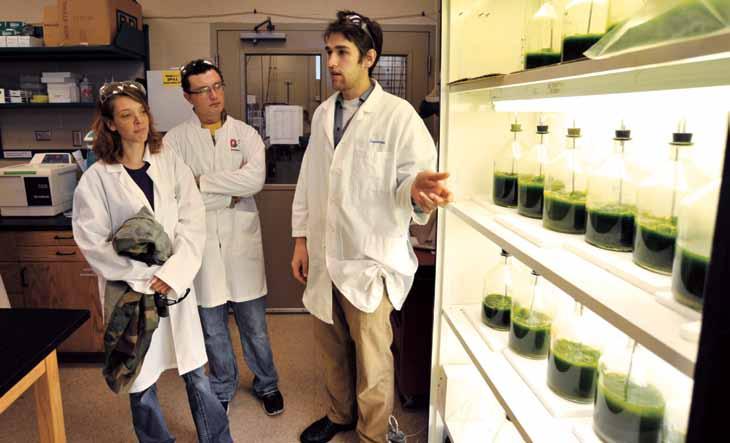
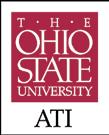


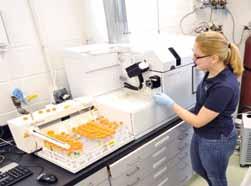



The Ohio Soybean Association (OSA) and Beck’s Hybrids share the belief that building a grassroots network of young agricultural leaders is important to the continued success of the soybean industry and all of Ohio agriculture. For this reason, OSA and Beck’s Hybrids have partnered to create the Beck’s Young Farm Leader Program to showcase the hard work, dedication and leadership of young Ohio farmers.
Identifying those who are the agriculture leaders of tomorrow is what the program is all about. Interested in applying or nominating someone? There are only a few qualifications:
• Growers must be between the ages of 21 to 45.
• Any soybean grower may apply for the Young Leader program; however selected participants are required to have a current Ohio Soybean Association membership to take part in the program.
• Applicants should demonstrate an interest in pursuing leadership roles within the soybean industry.
• Applicants are not required to grow Beck’s Hybrids products to be eligible to win.
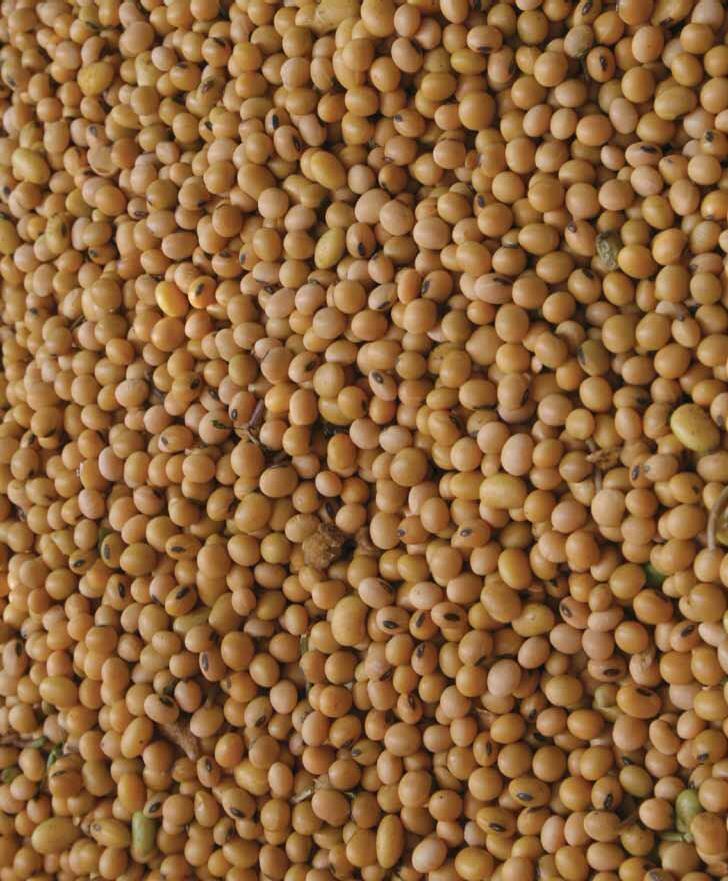
One farmer each quarter will be recognized in a story published in several Ohio agriculture publications highlighting the individual’s leadership roles, both on and off the farm, and how he or she has built a foundation for farming success.
At the end of the year, one of the Young Leaders will be selected as the 2013 Beck’s Young Farm Leader of the year. But it doesn’t stop there.
The 2013 Beck’s Young Farm Leader of the Year will receive a trip for two ($2,000 value) to the 2014 Commodity Classic in San Antonio, Texas.
Young leaders may also be chosen to attend OSA and Beck’s Hybrids leadership training programs, board meetings, events and/or any other relevant activities.
Program Timeline:
May 1, 2013 2nd Quarter applications due
August 1, 2013 3rd Quarter applications due November 1, 2013 4th Quarter applications due
Visit www.soyohio.org/becksyoungfarmleader to apply today!
More than 170 farmers and state soybean leaders gathered in Memphis, Tennessee in January for the American Soybean Assocation’s (ASA) 13th annual Soybean Leadership College. The event provided opportunities for future and current soybean industry farmer-leaders and state staff to learn how to engage other soybean producers, consumers, legislators, government officials and media. Training focused on personal and organizational leadership, personal communications and the latest issues in the soybean industry.
Ohio Soybean Association (OSA) treasurer and soybean farmer from Highland County, Jeff Roehm attended along with other OSA farmer-leaders.
“Soybean Leadership College offers any farmer the opportunity to engage in conversations that affect their daily lives,” said Roehm. “The days are filled with enlightening speakers and a room full of
people who love and want to continue to improve agriculture every day.”
As in years past, the event kicked off with a one-day State Leaders Summit which brought state association and Qualified State Soybean Board (QSSB) staff together with ASA and United Soybean Board (USB) leadership to discuss what issues will confront the industry in the coming months and years, and what issues are critical to each state. Facilitated by consultant and Futurist Bob Treadway, the State Leaders Summit helped attendees look at what road blocks and areas for success await the soybean industry.
Soybean Leadership College started with a presentation on membership strategies from association consultant Mark Levin followed by an inspirational general session from colorful radio personality and agriculture advocate Trent Loos on dealing with doubters and opponents of agriculture while advancing
the dialogue on production agriculture.
Attendees also chose to attend a variety of educational sessions which lasted both days. Topics covered included a crash course on viral and social media, a tutorial on telling the story of a farmer, and a panel discussion on water issues and conservation featuring former USDA Natural Resources Conservation Service (NRCS) Chief Dave White, ASA Executive Committee member and Delaware farmer Richard Wilkins, and Warren Formo, executive director of the Minnesota Agricultural Water Resource Center.
The event concluded with three education sessions where attendees learned about media tactics, sustainability, leadership strategies and wrapped up with an inspirational speech from agriculture advocates Troy and Stacy Hadrick who challenged attendees to discover new ways to tell the story of agriculture and influence a larger dialogue on farm issues. u
With spring fast approaching, it is vital for farmers to start preparations for the upcoming planting season. Dr. Scott Shearer, the Food, Agricultural and Biological Engineering department chair at The Ohio State University, believes that “everything starts with the planter and planter performance is tied to maintenance.” Preventative planning coupled with yearly maintenance could drastically help farmers – with emphasis on starting early in the season rather than later. Dr. Shearer has seen too many farmers wait too long after the winter cold to start preparing for planting season.
Minor maintenance problems could be fixed beforehand with less hassle
and less stress. Dr. Shearer points to several simple ways to prepare planters for the planting season. When upgrading technology, all monitors need to be tested beforehand to assure that they are working properly. Check to make sure all row units are stable and realign the row units yearly to prevent poor seeding quality. The down pressure control and sidewall compaction need to be checked on each individual unit, especially when planting corn to ensure the emergence of the corn seeds.
By spending time in the workshop preparing, you will have more time to spend in the fields later. Since we largely depend on good weather, the last place we want to be is in the shop while others are out in the fields. The key to being a step ahead of the weather is to start preparing earlier rather than later – so once the weather is ready, you are too.
The Ohio Soybean Council and soybean checkoff established the Soybean Rewards Program to identify and build awareness of existing incentive programs to help Ohio soybean farmers grow, market, and sell soybeans for a potential premium.


Our nation’s inland waterway system, including our inventory of locks and dams, is not simply a contributing factor to the success of U.S. soybean farmers, it is a dominant one. Other countries can produce soybeans at a lower price. However, it has been and continues to be the ability to deliver those soybeans to our customers in a cost-effective manner that helps U.S. soybean farmers maintain a competitive advan-
tage. For much of the key soybean growing regions of the country, barge transportation is the most economical, efficient mode for transporting soybeans to our export terminals.
Despite the widespread acknowledgement of the importance of our inland waterway system to the viability of the U.S. economy overall, including the soybean industry, the condition of our lock and dam inventory continues to degrade. Significant time, energy, and resources have been devoted by agriculture and other stakeholders to promote increased investment in the system, yet progress remains elusive. A recent study funded by the soybean checkoff suggests that it may be time to reevaluate how our nation manages and finances our lock and dam inventory.
“The Soy Transportation Coalition and other stakeholders in the inland waterway system are frustrated with the absence of progress over many years in enhancing our lock and dam system,” suggests Patrick Knouff, a soybean farmer from Minster, Ohio, and Chairman of the Soy Transportation Coalition and Vice Chairman of the Ohio Soybean Council. “We believe the time is right for some new thinking on this important issue.”
The study, “New Approaches for U.S. Lock and Dam Maintenance and Funding,” was performed by the Texas Transportation Institute at Texas A&M University. The analysis highlights many of the inadequacies of the current efforts of managing our lock and dam system and how alternative funding and maintenance strategies have the potential to yield better results.
One of the key deliverables from the study is comparing major maritime infrastructure projects in other countries with those in the U.S. – particularly in the ability to complete projects on time and within budget. The Panama Canal expansion and the construction of the Deurganck Lock at the Port of Antwrep were specifically highlighted. “It is discouraging to observe how many other countries are able to construct their ma-
jor infrastructure projects much more efficiently than we can,” explains Mike Steenhoek, executive director of the Soy Transportation Coalition. “Many of these projects are more imposing and complex than any project we have underway or planned in our inland waterway system, yet these projects are completed within budget and on schedule. Compare this to our Olmsted Lock and Dam project that had an original cost estimate of $775 million and has recently been updated to over $3.1 billion with a significant time horizon remaining before it will be completed. When examining the various reasons for our repeated cost overruns and project delays, it quickly becomes evident that a major contributing factor is the piecemeal and unpredictable manner in which we finance these projects.”
money is just as important as how much money is allocated,” explains Steenhoek. “A bigger check from the government is not the only solution. Better stewardship is also essential.”
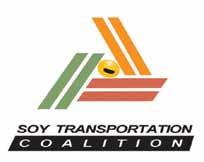
Major investments of any nature –particularly infrastructure investments – require a system of funding that provides the money up front in a lump sum, or at least provides certainty that the incremental installments will be allocated. Our current system provides neither. The research cited the McAlpine Lock and Dam project on the Ohio River, near Louisville, and how it received, on average, only 61 percent of full capability funding levels. The study identifies how such an unpredictable and insufficient funding stream resulted in a 38 percent cost escalation and a project completion delay of 6 ½ years.
The analysis further examines the feasibility of instituting a bonding style approach to lock and dam financing. If implemented, priority projects could achieve greater funding in an initial lump sum – decreasing the likelihood of the cost overruns and delays pandemic among our lock and dam system. “Our research highlights that how you allocate
“The other major principle advanced in our analysis is that a predictably good inland waterway system is better than a hypothetically great one,” says Steenhoek. “During this period of fiscal scarcity, we are concerned that our nation is failing not only in providing new and expanded locks and dams, but also in maintaining and preserving our current inventory. A preferable approach may be to first demonstrate stewardship of current locks and dams by providing assurance to users that a lock and dam, in the event of a major failure, will be operational within 48 or 72 hours, for example. If we allocate our resources in a manner that provides this degree of predictability to those who utilize our inland waterway system, we believe that will provide a superior message to the one we are currently sending.”
According to the research, the cost of one lock construction project ($376.8 million) is approximately equal to the cost of nine major rehabilitation projects ($40.7 million). If each of the nine new construction/expansion projects currently underway were downgraded to a major rehabilitation, their total cost would drop to $366.3 million compared to the listed total of $3.2 billion – a difference of $2.8 billion.
Knouff explains, “We believe that given the budget constraints facing our nation for the foreseeable future, it is important to promote allocating scarce resources for optimal effect. We believe this involves prioritizing preservation and maintenance of our locks and dams.”
The full results of the study can be accessed at www.soytransportation.org or www.unitedsoybean.org. u

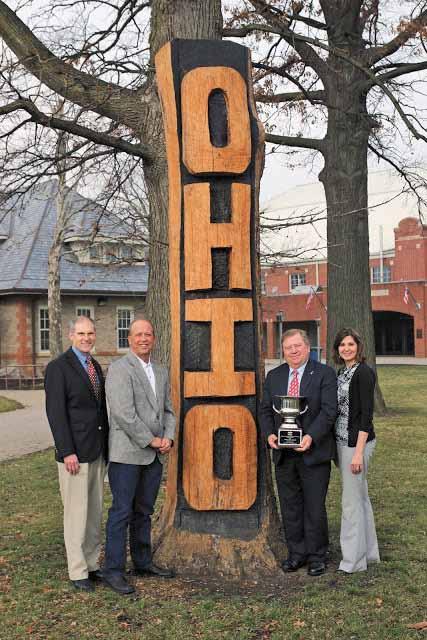
The Ohio State Fair, in conjunction with the Ohio Soybean Council (OSC), and the soybean checkoff received an award of distinction in the inaugural Soybean and Environmental Sustainability Awards competition from the International Association of Fairs and Expositions (IAFE) for its soybean education program at the 2012 Ohio State Fair.
In addition to receiving first place in its attendance division for the “educational event, exhibit or program for the fairgoing public – soy use” category, the Ohio State Fair was presented with the coveted Judge’s Choice Award for the entire Soybean and Environmental Sustainability Awards competition, which recognized fairs in four different categories, and in each of five divisions based upon attendance. The entries were evaluated and judged by a team of industry leaders selected from the membership of the IAFE.
The multi-faceted program was developed in partnership with OSC to educate fairgoers, farmers and concession vendors about the state’s most abundant and versatile crop, the soybean:
• Many concessionaires made their fried foods healthier by adopting the use of trans fat-free high-oleic soybean oil in their food booths, featuring educational signage alongside the delicious treats.
• Various additional soy-based products, such as hand sanitizer and paint, were used throughout the 360-acre Ohio Expo Center.
• A final educational element was the sponsorship of several buildings and the entire junior livestock show, capped with Ohio Soybean Day, Saturday, Aug. 4. On this day, Ohio soybean farmers greeted fairgoers and answered questions about the uses of soybeans and how farmers grow them. Additionally, potted soybean plants along with signage sharing interesting facts such as “one acre of soybeans can produce 82,368 crayons” were located throughout the grounds.
The Soybean and Environmental Sustainability Awards were developed to encourage fairs to utilize soy products in their operations, educate the public about the soy products, to incorporate environmentally sustainable practices in fair operations as well as to educate the fairgoing public about environmentally sustainable practices.
“The Ohio Soybean Council was honored to have received recognition for the education program at the Ohio State Fair,” said John Motter, Ohio Soybean Council chairman and soybean farmer from Hancock County. “Consumers have questions about how their food is raised and Ohio soybean farmers were there to address those questions. OSC will continue to communicate to consumers and show how many goals and values farmers and nonfarmers have in common when it comes to America’s food.” u

The Ohio Livestock Coalition (OLC) recently announced that funding is available for Ohio organizations interested in hosting meetings for farmers and farm managers on water quality and nutrient management education.
Water quality and nutrient management are issues that affect all farmers, farm managers and anyone who buys, sells or manages manure or uses fertilizer.
To apply for funding, an intent form must be submitted to OLC at least 30 days prior to the scheduled meeting date. Applicants’ intent forms must demonstrate how the meeting will educate attendees on water quality and nutrient management issues, including:
• Promoting the 4Rs of nutrient management;
• Impact of nutrients on water quality;
• Promoting the use of best management practices (BMPs);
• Availability of cost share programs to address this specific issue;
• The benefits of using manure as a nutrient and its role in water quality;
• Voluntary action vs. regulatory action; and
• Developing trust with the public regarding this issue.
OLC will reimburse up to $10/person attending, with a maximum total reimbursement of $500 for hosting an educational and informative water quality and nutrient management meeting. Following the meeting, funding recipients must submit a report form, provided by OLC, within 30 days to report the results of the event and how the funding was used.
To learn more about this opportunity, as well as to obtain intent and report forms, visit OLC’s website at www.ohiolivestock.org.u

BiodieselNow, a new app offered by the National Biodiesel Board (NBB), gives users the ability to quickly find biodiesel fueling stations, track fuel purchases and earn rewards.
Introduced at the 2013 National Biodiesel Conference, the app is available for both Apple and Android devices and provides valuable mapping information on biodiesel fueling stations across the U.S.
BiodieselNow app users can stay up-to-date on the latest biodiesel news, including federal and state regulations, quickly locate biodiesel fueling stations, and easily log their biodiesel usage along the way. Every gallon of fuel purchased earns biodiesel reward points that are redeemable toward biodiesel merchandise in NBB’s online store.

“This app puts America’s advanced biofuel in the palm of your hand. We are very excited to be able to participate more actively in the mobile communication world and use the latest technology to get even more people tuned in to biodiesel,” said Doug Whitehead, NBB director of operations. “As the biodiesel industry continues to advance and consumption grows, we feel it’s important to help users find those retail locations and improve communication between NBB and the industry.”
There are hundreds of retail stations making biodiesel blends available to the public both at filling stations and fuel docks. The BiodieselNow app could not have been launched at a better time and makes finding those stations easier than ever before. Download the app at http://app.biodiesel.org u

The Ohio Soybean Council (OSC) and soybean checkoff are committed to funding the research, development and commercialization of new industrial uses for soybeans. In fact, through a broad range of initiatives, soybeans play a key role in creating a wide variety of new innovative products.
Recently, scientists at Battelle, a global research and development organization based in Columbus, Ohio have developed a chemistry to make diapers and other absorbent products friendlier to the environment while remaining cost competitive.
Diapers and other materials that absorb liquids are effective because of hydrogels, or as scientists call them, superabsorbent polymers (SAP), petroleum-based acrylic acid materials, which can absorb hundreds of times their weight in liquid. The market for SAPs today is about 1.6 million tons per year, with personal care items making up the vast majority.
The science behind it all involves using soybean meal to replace 33 percent of the acrylic acid-based SAPs while keeping the same absorption rate and comparable price point.
“We believe that everyone wants to be environmentally friendly, but they want products that perform exactly the same as
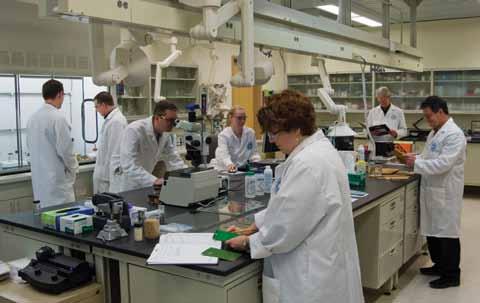
Scientists at Battelle have worked with the
for many years to develop new uses for soybeans. Soy hydrogels are one of many products that will be commercialized in the coming years.
their oil-based counterparts without costing more,” said Marty Toomajian, President of Battelle’s Energy, Environment and Material Sciences Global Business.
In potted plants, similar to what you would find at Home Depot or Lowes, soy hydrogels can be added to lock in moisture so less water is needed to keep the plants viable. The soy hydrogels can also be used as a seed component helping to absorb water when there is lack of rain. This is currently being used on grass seed and perhaps in the future on row crops.
“Soy hydrogels will provide profit opportunities for farmers across Ohio and around the United States,” said Keith Roberts, OSC board member and soybean farmer from Marion County who also serves as chair of the OSC new uses committee. “Soybean meal in industrial applications has tremendous potential and could be a huge market.”
Battelle expects soy hydrogels to be commercialized within the next 2-3 years. Licensing is currently available and Battelle continues to work with companies who may benefit from this technology.
This isn’t the first time OSC has collaborated with Battelle on soy research. In past years, scientists at Battelle have created soy-based flexible foams for bedding and furniture, toner for printers, lubricants, coatings, plasticizers and many other products as a replacement for petroleum-based materials.
OSC and the soybean checkoff will continue to invest in soy-based research to reduce our reliance on petroleum. The world is seeking out environmentally friendly renewable resources and soybeans are part of that solution.
For more information on soy bioproducts currently available in the marketplace, visit www.soyinside.org. u
“We believe that everyone wants to be environmentally friendly, but they want products that perform exactly the same as their oil-based counterparts without costing more,” said Marty Toomajian, President
of Battelle’s Energy,
Environment and
Material Sciences Global Business.








HARVESTED 4,580,000 ACRES
PRODUCED MORE THAN 206 MILLION BUSHELS OF SOYBEANS THAT YIELDED AN AVERAGE OF 45 BUSHELS PER ACRE
$5.3 BILLION – ANNUAL ECONOMIC IMPACT FROM SOYBEAN PRODUCTION
BEST YIELD PER ACRE IN THE NATION, 5.4 BUSHELS ABOVE THE NATIONAL AVERAGE OF 39.6 6TH TIED FOR
RANKED 6TH IN SOYBEAN PRODUCTION ACROSS THE UNITED STATES
www.unitedsoybean.org
www.soyohio.org





The Soybean Pathology Program spent a lot of time on the road last summer evaluating different management practices for Ohio’s prominent soybean pathogens. We planted 1,676 plots to evaluate material in 39 tests from 10 companies in addition to our own field tests. These plots spanned 11 field sites across 9 counties in Ohio.
The following is a list of where we did find some differences.
1) Sudden Death Syndrome. This disease is caused by a fungus and some new data from Leonor Leandro at Iowa State University suggests that infections actually occur shortly after planting. We also know that symptoms and effects of this disease are enhanced when infections occur in the presence of soybean cyst nematode. We evaluated 148 MG III entries in a field with SCN egg counts ranging from 200 to 2,000 eggs/cup of soil. SDS developed at this location and 60%
of the entries developed no symptoms or a trace amount. This is very encouraging to see that more lines have high levels of resistance to this root pathogen.
2) Soybean cyst nematode – we were able to assess yield differences between SCN resistant and SCN susceptible varieties at one location, where there was a 35% yield difference or loss from planting a susceptible variety. For other locations, all of the varieties were resistant and there were no significant differences among the treatments that we evaluated. We are still processing fall soil samples from 210 plots - as soon as those are complete we will have more reports. We planted 876 plots to SCN and SDS tests.
3) Seed treatments for Phytophthora sojae and Pythium spp. We evaluated 108 different treatments at the Phytophthora field at OARDC Northwest Research Station. This study, which had 600 plots, received very minor disease pressure. This
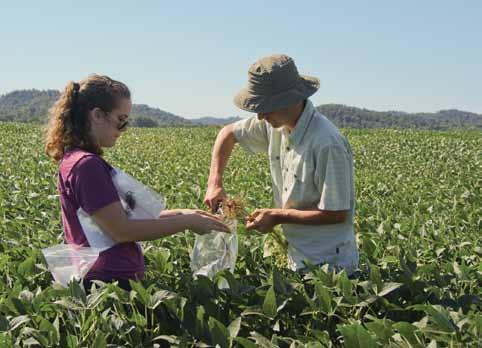
is the first year that our cross aisles, which are planted to a super susceptible variety did not all die. Despite this low disease pressure, we did get a significant difference for seed treatment in one study. Yield from seed of a susceptible variety, which was treated with ApronXL at 0.64 fl. oz/cwt, had significantly higher yield (9 bu/A) than that of the nontreated. Yields were also significantly different at a second location for seeding rate study, seed treatment, and a variety evaluation.
4) Fungicides – We also evaluated the efficacy of fungicides towards other soil borne pathogens (Rhizoctonia, Fusarium graminearum); foliar pathogens (Frogeye Leaf Spot) and Sclerotinia stem rot (white mold). Many of these compounds have not been labeled nor has the final formulation been developed. Our Sclerotinia field had less than 20% disease – mostly down in the 3% range for both nontreated and treated areas of the field. Frogeye leaf spot developed in parts of the field with 3 to 18% of the leaf area affected on individual leaves. Yield loss could be measured in some areas of the field with a 4.5 and 7 bu/A difference between treated and non-treated areas of the field. All of the fungicides reduced the incidence and severity of Frogeye Leaf Spot. u
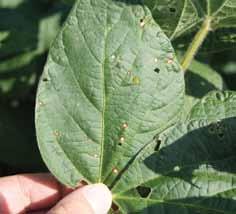

Soy oil has been losing ground in the food oil market in recent years as consumers seek alternatives for a variety of reasons, including the issue with trans fats resulting from processing the soybean oil. As consumers make choices in the marketplace, soybean farmers need to be making choices accordingly to address this challenge.
“This will be my third growing season with the high oleic platform,” said John Motter, Ohio Soybean Council (OSC) chairman and Hancock County soybean farmer who also serves on the United Soybean Board (USB). “That first year I had about 15% of my production in high oleic. Last year I stepped it up to 85% and
High oleic soy oil’s increased functionality and stability gives it the potential to take back lost edible-oil market share and expand the use of soy oil in industrial applications.

I am going to be 100% high oleic this coming crop year. We have to move our industry from just a common commodity bean to value added products,” said Motter.
“We have to do things in the industry that have the end user in mind. We’ve got to look beyond the elevator to the end user and their needs and satisfy those needs.”
The high oleic content of the soybeans makes the oil extremely stable, which eliminates the need for partial hydrogenation that results in trans fats. High oleic builds upon the success of low linolenic soybeans.
To regain lost ground in the oil market, USB leaders determined that there was a need to give the process another boost. For this reason, a new soybean checkoff funded market-development campaign has been developed to promote the benefits of high oleic soy oil both to the farmers who grow soybeans and the food companies and industrialproduct manufacturers using the oil. The promising benefits of high oleic soybeans could build more than 8 billion pounds of demand for U.S. soy in the food and industrial sectors,
which requires the oil from 718 million bushels of soybeans.
“High oleic soy oil’s increased functionality and stability gives it the potential to take back lost edible-oil market share and expand the use of soy oil in industrial applications,” said Jim Call, USB vice chair and a soybean farmer from Madison, Minn. “It’s about meeting our customers’ needs, and high oleic does just that.”
The soybean checkoff program will be carrying the message of high oleic oil’s market potential to farmers and encourage them to grow the varieties when they become available in their areas. To help build demand for high oleic oil, the soybean checkoff will make the oil available to food manufacturers and food-service companies for performance and product-formulation tests. The soybean checkoff will also partner with chefs, build recipes and hold cooking demonstrations to promote the oil.
According to Motter, the soybean checkoff has already partnered with DuPont Pioneer and Monsanto to make the varieties available to as many farmers as possible as quickly as possible.
“We’ve got to get growers to embrace it and broaden the base of available maturities so that more farmers have the opportunity to grow them and expand across the Soybean Belt. We are going to partner with the industry and develop different maturities so that more beans will be available in more locations for farmers in Minnesota, Ohio and possibly up into Nebraska.”
“We need to pull this through from consumer demand and push it through the seed companies. Between that pull and that push, we should be able to develop a value chain for our soybeans,” said Motter.
High oleic soybeans also offer advantages for industrial markets, including hydraulic oils and motor oils that have thus far eluded the soy oil market.
For more, visit http://www.unitedsoybean.org. u
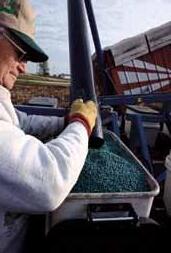


The Ohio Soybean Council and soybean checkoff have worked on a variety of projects to promote U.S. meat overseas. As international demand for U.S. meat products continues to grow, so will the domestic demand for high quality soybean meal. Beef and pork exports remain vital to farmers because of the direct impact on soybeans.
U.S. beef and pork exports set new value records in 2012, topping highs set in 2011, according to end-of-year statistics released by USDA and compiled by the U.S. Meat Export Federation (USMEF).
The achievement was more significant in light of challenging export conditions that included non-science-based trade barriers in several key markets and an anemic economy in certain regions.
“The export markets are a critical profit center for the industry at a time when the industry is challenged by high input costs and, on the beef side, a historically low herd size,” said Philip Seng, USMEF president and CEO. “2012 saw record highs for per-head export values for both pork and beef at a time when those returns were sorely needed by producers.”
Pork exports set both volume and value records last year,
reaching 2.26 million metric tons (mt) – up a fraction from the record set in 2011 – valued at $6.3 billion, a 3.5 percent increase over the prior year’s record. The per-head export value of U.S. pork exports set another record in 2012, reaching $55.87, up 1 percent from 2011. For the year, exports accounted for 27 percent of total pork production and 23.4 percent of pork muscle cut production versus 27.5 percent and 23 percent, respectively, in 2011.
The value of beef exports for the year rose 2 percent to a record-high $5.51 billion on 12 percent lower volumes (1.13 million mt). The per-head export value for beef hit $216.73, a $10.36 increase over 2011. Contributing to that was a new monthly record value of $242.65 set last December. For the year, U.S. beef exports accounted for 12.7 percent of total beef production and 9.8 percent of muscle cut production. This compares to 14.2 percent and 11 percent, respectively, in 2011.
Looking ahead, the outlook for 2013 appears positive for both the U.S. beef and pork industries, according to Seng.
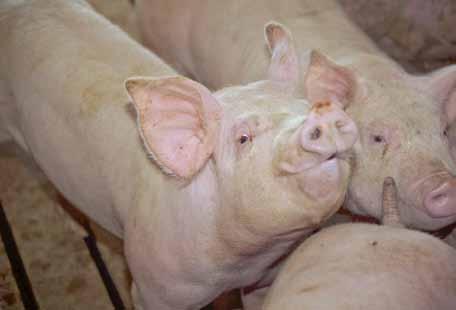
“There are many factors that go into projecting 12 months into the future, but as we continue to focus our efforts on markets that offer the greatest potential for growth, we are optimistic
• Nearly 85 million bushels of soybeans were exported through U.S. red meat in 2011.
• Every pound of U.S. pork exported represents the utilization of 1.3 pounds of U.S. soybeans.
Source: U.S. Meat Export Federation

that 2013 will give us the opportunity to maintain the momentum we have seen in pork exports while rebounding in beef,” he said. The recent opening of Japan to U.S. beef under 30 months of age contributes to a projected growth in beef exports of 4 percent in volume (to 1.17 million mt) valued at more than $6 billion. That total may be tempered if issues with exports to Russia are not resolved.
The projection for pork calls for steady to slight growth, with exports likely to still exceed 2.2 million mt valued at more than $6 billion with key risk factors including Russia and domestic production in China. On the bullish side, U.S. pork is an extremely versatile, high quality protein at a great value that will gain market share in key export markets. Continued growth to top volume market Mexico is also expected to boost the bottom line. u
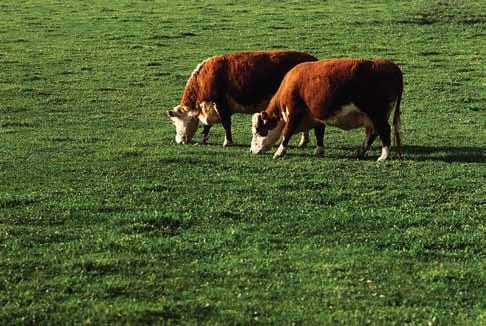
Located in the western Pacific ocean, 14,000 square miles with a population of 23 million, the second highest population density in the world, lies Taiwan, an island South East of mainland China.
While Taiwan remains small in size, the demand for U.S. soybeans remains large. On a per capita basis, Taiwan ranks second to Canada among major export markets as a consumer of U.S. food and agricultural products. In fact, U.S. soybean farmers exported a record $25,580 billion dollars of soybeans during the most recent marketing year. Out of that total, 55.9 million bushels went to Taiwan making it the fifth largest market for U.S. whole soybean exports.
Ohio soybean farmers can capitalize on the Taiwanese market with both food grade and commodity soybeans. The food grade market is popular among international markets, and the Ohio Soybean Council (OSC) continues to work closely with international customers and build new demand every day. Ohio consistently produces quality soybeans with high levels of protein content. This is one of the main advantages of Ohio, which is known among international customers for quality soybeans. u
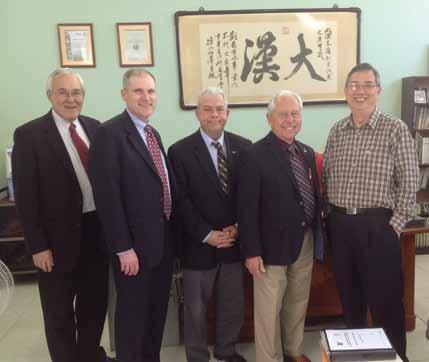
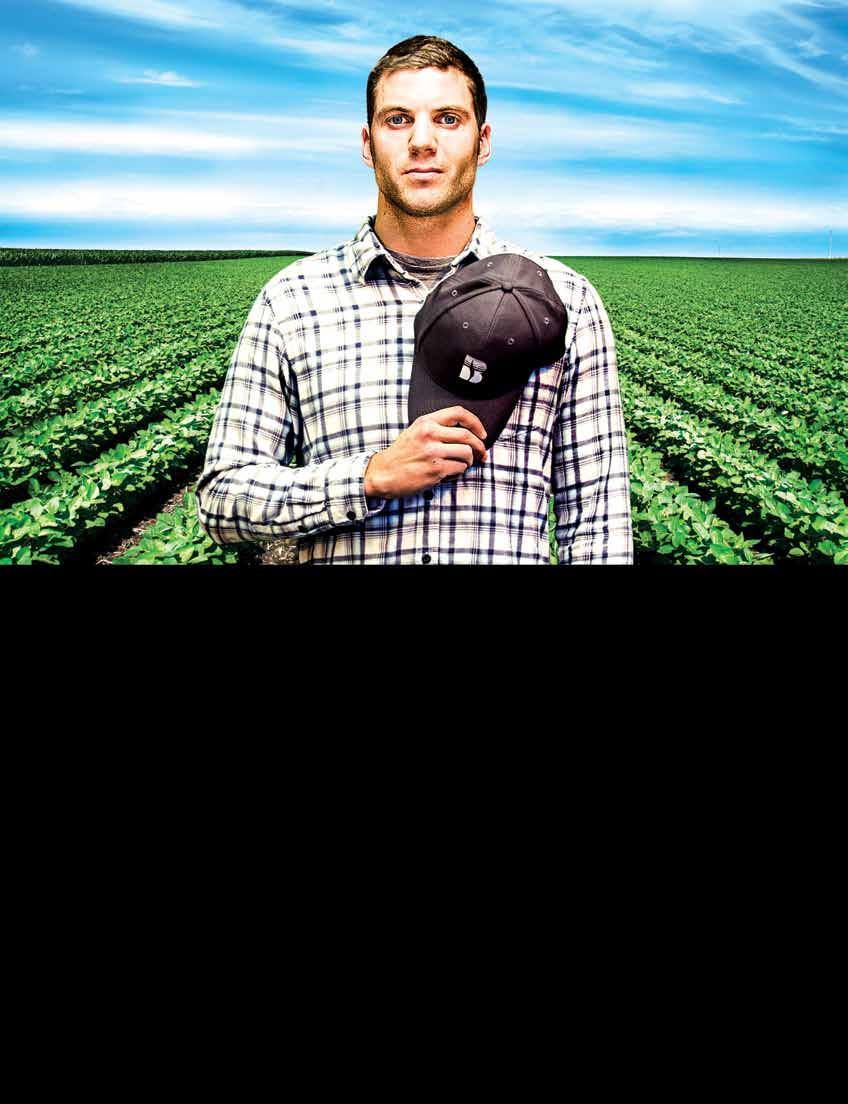
“I pledge my loyalty to the fight against glyphosate resistant weeds, and to my fields upon which they grow, for all farmers, with liberty and no weeds for all.”
Glyphosate is a great herbicide, however, continued use has resulted in weed resistance throughout the Midwest. Take Beck’s Liberty® pledge and be free of weed resistance. Claim your freedom. Plant Beck’s. Choose Liberty. Take advantage of the LinkUp offer from Bayer CropScience and receive a cash-equivalent rebate of $5/unit on your Beck’s LibertyLink soybean seed! Call 1-800-937-2325 or visit www.beckshybrids.com/libertysoybeans.